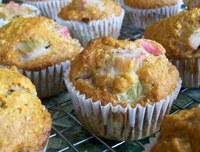Prairie Fare: Are Rhubarb and Tomatoes Fruits or Vegetables?
(Click an image below to view a high-resolution image that can be downloaded)
By Julie Garden-Robinson, Food and Nutrition Specialist
NDSU Extension Service
“For roll call, please say your favorite vegetable,” our club officer announced.
I was at a meeting of PEO, which is a philanthropic educational organization for women. We in Chapter V are getting to know each other a little better every month by answering questions for roll call.
The officer stated green beans as her favorite. Then someone announced “rhubarb” as her favorite vegetable.
“Isn’t rhubarb a fruit?” another person asked.
Then the laughter and spirited discussion began.
Several looked at me, the off-duty food and nutrition specialist. I was contemplating whether broccoli or green beans would be the favorite vegetable I’d say, so I wasn’t paying a lot of attention.
“Fruits have seeds,” I replied a bit feebly.
“Rhubarb is a vegetable,” someone said as she held up her cellphone. The internet is pretty handy.
A couple of people stated “tomatoes” as their favorite vegetable.
“Oh, boy, here we go,” I thought to myself. I have been down this path previously in nutrition education.
The answer to whether tomatoes, rhubarb, cucumbers, green beans or squash are fruits, vegetables or something else depends on your perspective. If you are examining tomatoes as a botanist, yes, they’re fruits. Technically they are “the mature ovaries of a plant,” or the structure that bears the seeds of the plant.
We in nutrition usually do not think of fruits as “mature ovaries,” but that might be an interesting point of trivia to share if you run out of conversation starters.
Nutritionists generally classify foods based on their typical use in recipes and menus. Tomatoes often are used in salads or pasta sauces, so we consider them vegetables.
Vegetables, on the other hand, usually are roots, stems and leaves. Carrots, onions, lettuce and potatoes fit the description. Visit http://www.choosemyplate.gov for our latest nutrition guide. You’ll find squash, pumpkin and cucumbers in the vegetable section because that is how they are used on the menu.
By the way, green beans are botanically “legumes,” so I need to change my favorite vegetable answer to “broccoli.”
To add even more fun to food classification, sometimes a vegetable can be a grain. In the U.S. Department of Agriculture nutrition guidance, corn is considered a starchy vegetable. Cornmeal is in the grain group and is used in breadlike items, such as muffins.
If you’re taking a botany class, you will want to know the right answers for an exam. If you’re in a nutrition class, you’ll need to change your perspective.
Overall, we in nutrition don’t mind if you count your tomatoes and rhubarb as vegetables or fruits. Bottom line: We really want you to eat more colorful fruits and vegetables for all their health benefits.
People fall short of the orange and dark green subcategories of vegetables, so make a point of adding more squash, sweet potatoes, dark green leafy lettuce and broccoli to your plate.
How about rhubarb, that seasonal favorite food? Most of us have enjoyed rhubarb in crisps, jams, sauce or pies. In fact, rhubarb also is known as “pie plant.”
Rhubarb has just 26 calories per cup, but the low-calorie content is offset by the amount of sweetener needed to overcome its tartness. Rhubarb also provides vitamin C and fiber. Here’s a tasty recipe courtesy of the Utah State University Food Sense Program.
Kid-approved Rhubarb Muffins
1 c. all-purpose flour
1 c. whole-wheat flour
1 1/2 tsp. baking powder
1 tsp. baking soda
1/2 tsp. ground cinnamon
1/2 tsp. salt
3/4 c. light brown sugar
2 eggs, beaten
1 c. milk
1/4 c. canola oil
1 tsp. lemon juice
1 1/2 c. fresh rhubarb, finely chopped
Preheat oven to 375 F. Spray 18 muffin cups with cooking spray. (If you prefer, you can use cupcake liners.) In a mixing bowl, combine the flours, baking powder, soda, salt and cinnamon; set aside. In a separate bowl, beat together the brown sugar, eggs, milk, oil and lemon juice until well-combined. Add the moist ingredients to the dry ingredients and stir until just combined. Fold in the rhubarb. Portion into muffin cups. Bake for 15 to 20 minutes. Cool for five minutes, then remove from pan.
Makes 18 servings. Each serving has 140 calories, 4 grams (g) fat, 3 g protein, 22 g carbohydrate, 2 g fiber and 150 milligrams sodium.
(Julie Garden-Robinson, Ph.D., R.D., L.R.D., is a North Dakota State University Extension Service food and nutrition specialist and professor in the Department of Health, Nutrition and Exercise Sciences.)
NDSU Agriculture Communication - June 15, 2017
| Source: | Julie Garden-Robinson, 701-231-7187, julie.garden-robinson@ndsu.edu |
|---|---|
| Editor: | Ellen Crawford, 701-231-5391, ellen.crawford@ndsu.edu |



